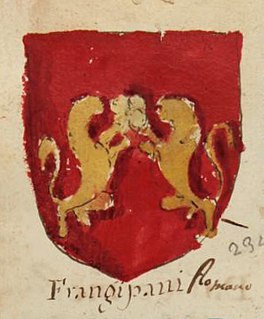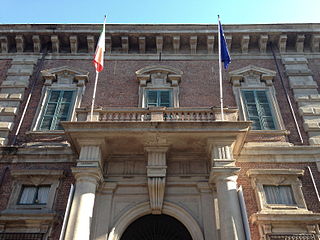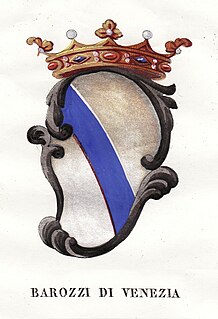Related Research Articles

The Pazzi were a noble Florentine family in the Middle Ages. Their main trade during the fifteenth century was banking. In the aftermath of the Pazzi conspiracy in 1478, members of the family were banished from Florence and their property was confiscated; anyone named Pazzi had to take a new name.

A seraglio or serail is the sequestered living quarters used by wives and concubines in an Ottoman household. The term harem is a generic term for domestic spaces reserved for women in a Muslim family, which can also refer to the women themselves. The Ottoman imperial harem was known in Ottoman Turkish as Harem-i Hümâyûn.

Pietro Consagra was an Italian sculptor. In 1947 he was among the founding members of the Forma 1 group of artists, who advocated both Marxism and structured abstraction.

Massimo Pallottino was an Italian archaeologist specializing in Etruscan civilization and art.

Pietro Romanèlli was an Italian archaeologist.

The Frangipani family was a powerful Roman patrician clan in the Middle Ages. The family was firmly Guelph in sympathy. The name has many spellings, which include Frangipane, Freiapane, Fricapane and Fresapane. In his Trattatello in laude di Dante, Boccaccio traces the descent of Dante from the family.

Sandro Chia is an Italian painter and sculptor. In the late 1970s and early 1980s he was, with Francesco Clemente, Enzo Cucchi, Nicola De Maria and Mimmo Paladino, a principal member of the Italian Neo-Expressionist movement which was baptised Transavanguardia by Achille Bonito Oliva.

The Sicilian Buttercup is a breed of domestic chicken originating from the island of Sicily. The breed was imported to the United States in the 19th century, and to Britain and Australia early in the 20th century. It derives from the indigenous Siciliana breed of Sicily, but long separation from the original stock has led to marked differences between the two.

The Accademia di Belle Arti di Brera, also known as the Accademia di Brera or Brera Academy, is a state-run tertiary public academy of fine arts in Milan, Italy. It shares its history, and its main building, with the Pinacoteca di Brera, Milan's main public museum for art. In 2010 an agreement was signed to move the accademia to a former military barracks, the Caserma Magenta in via Mascheroni, but the move had not happened by early 2017.

Carciofi alla giudìa is among the best known dishes of Roman Jewish cuisine. The recipe is essentially a deep fried artichoke, and originated in the Jewish community of Rome, giudìo being the Roman dialect term for Jew. It is a speciality of the Roman Ghetto, where it is served by Jewish restaurants in the springtime. In English the dish is usually referred to with the standard Italian spelling Carciofi alla giudea; this spelling may be found in Italian sources as well, but the Roman dialect name is much more commonly used.
Enrico Alleva is an Italian ethologist. He has been president of the Società Italiana di Etologia since 2008.
Guglielmo Janni, was an Italian painter belonging to the modern movement of the Scuola romana .

Agnolo Monosini was an Italian scholar and cleric of the 16th and 17th centuries, who played a key role in the development of the Italian language two hundred years prior to the risorgimento.

The Landi were a noble family from Piacenza, in northern Italy. From 1551 to 1582, they were princes of the Val di Taro, now in the province of Parma, at that time in papal territory. Their principality is sometimes called Lo Stato Landi ; although the term is not well known, there is substantial documentation of it in the Archivio Segreto Vaticano, in the Vatican City.
Marcello Landi (1916-1993) was an Italian painter and poet.
Orazio Bacci was an Italian Liberal Party politician. He was the 12th mayor of Florence, Kingdom of Italy. He died in Rome.

The Barozzi were an aristocratic Venetian family. Members of the family became sailors, clerics and men of learning. They were lords of Santorini and Thirassia, and held military fiefs on the island of Crete. Members of the family were involved in the conspiracy of Bajamonte Tiepolo against the Doge of Venice in 1310.

The Premio Mylius was an Italian prize for painting. It was established by the Austrian industrialist Heinrich Mylius in 1841 and awarded by the Accademia di Brera in Milan, which at that time was under Habsburg rule. In 1856 there were two types of award, an annual prize of 700 Austrian lire for a painting in oils, and a biennial award of 1000 lire for fresco work. It was awarded until the outbreak of the Second World War.

Alessandro Casati was an Italian academic, commentator and politician. He served as a senator between 1923 and 1924 and again between 1948 and 1953. He also held ministerial office, most recently as Minister of War for slightly more than twelve months during 1944/45, serving under "Presidente del Consiglio" Bonomi.

Giovanni Pietro Toesca was an Italian academic and art historian, notable as one of the most important historians of medieval to 20th century art. His La pittura e la miniatura nella Lombardia fino alla metà del Quattrocento was the first attempt to reconstruct the course of figurative Lombard art from the middle ages onwards, defining its importance across Europe.